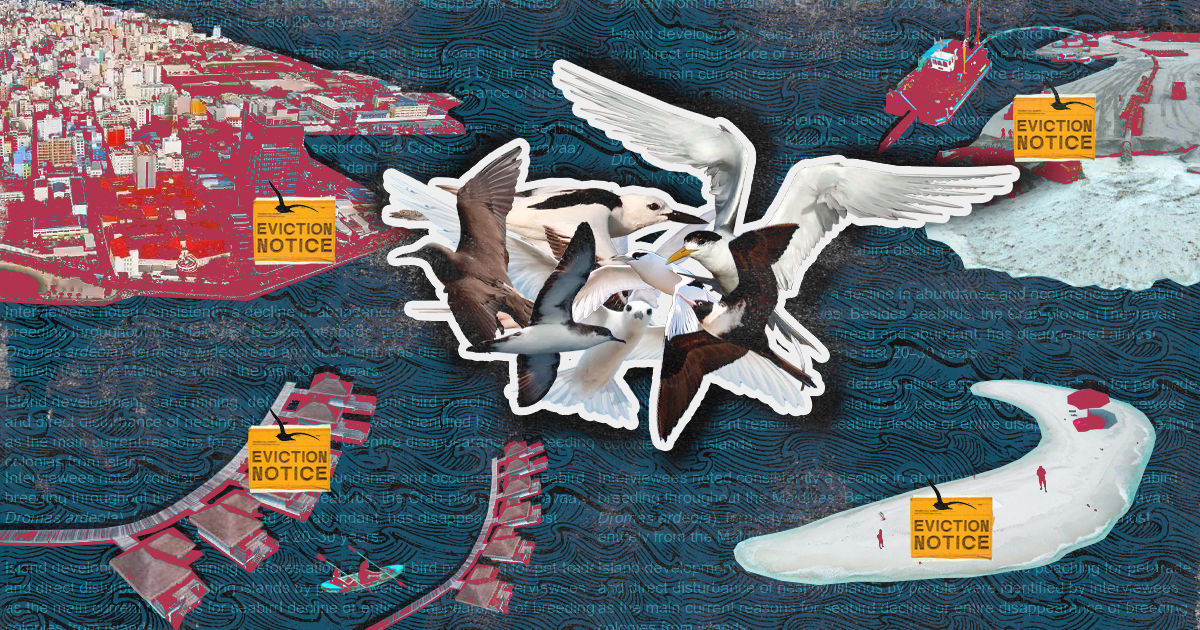Empty skies, lost songs: Maldives faces seabird extinction crisis
A generation has never seen the birds that once filled the skies.

Artwork: Dosain
29 May 2025, 8:23 PM
The birds above schools of fish that guided Maldivian fishermen for centuries are vanishing, a collapse so complete it could erase an entire cultural heritage.
The haunting melody of the 90s anthem Theyravaa might soon be all that remains of the crab-plover that filled the skies and thrived for generations. Previously common sightings of the abundant wader species have “almost entirely ceased to occur in the last 20 to 30 years,” according to a new report by the Environmental Protection Agency.
“The crab-plover’s popularity and occurrence in Maldivian folklore and music (e.g. the popular song ‘Theyravaa’) underlines its former commonness and stands as a stark example for how the disappearance of birdlife from the Maldives not only impacts biological but also cultural diversity through the loss of a unique element of Maldivian culture, which shares a deep interrelationship and connection with many native bird species through storytelling, idioms, music and folklore,” the report observed.
The report identified human pressures such as dredging, land reclamation, tourist activity and resort development as factors contributing to the drastic decline in seabirds populations, confirming a long-held belief among fishers that their crucial guides are disappearing.
The crab-plover’s fate mirrors a broader crisis affecting seabirds in the region.
The EPA gathered data on the atoll level distribution of common breeding and migratory birds by interviewing over 42 knowledgeable and expert local community members, including one from each administrative atoll. The research focused on 29 species of birds, shortlisted based on breeding status, commonness and abundance. These included 13 seabirds, 10 herons and allies, three waterbirds, one wader and two land birds.
Several seabird species such as the brown noddy (maaranga) and lesser noddy (kurangi) were previously known to breed in the Maldives. But they are now mostly migratory birds, the report found.
“Birds above schooling fish”
The Dhivehi phrase for seabird, ainmathee dhooni, roughly translates to birds above schooling fish. Seabirds predominantly forage at sea and return to land only for breeding and roosting. For centuries, Maldivian tuna fishermen have relied on sightings of seabirds to locate schools of fish.
Seabirds are drawn to the Maldives archipelago because of major oceanic currents intersecting Maldivian atolls, which combined with monsoon climate forces, cause seasonal upwelling events. These upwellings result in exceptional marine productivity and abundant marine megafauna, creating productive fishing grounds.
As a result, seabirds breeding in Seychelles, Chagos, Western Australia, the Arabian Sea, and Antarctica migrate to the Maldives during their non-breeding season. Research conducted as recently as 2012 confirmed that seabirds remained a major "tool" for fishermen to locate fishing grounds.
Seabirds face threats both on land and at sea, including from predators such as rats, house mice, and feral cats.
Habitat loss and human disturbance pose another major threat, with tourism, construction, sand mining, and poaching making them more vulnerable.
“Interviewees recalled repeatedly that major seabird breeding or roosting islands were developed as resorts, reclaimed by urban development, or destroyed through sand-mining activities,” the report stated.
Frequent and unregulated visits by tourists and locals to sandbanks disrupt breeding behaviour, leading to the abandonment of seabird breeding islands. “Deforestation of inhabited islands for development, often involving the clearance of all vegetation, has also been linked to the decline and disappearance of birds from islands,” it added.
The vanishing of native birds will not just be a loss to ecosystems but a loss to Maldivian culture, the report suggested. Seabird occurrence and breeding patterns are known to be associated with specific nakaiy, a codified system of two-week intervals that guided Maldivians through monsoon cycles.
Traditional bird poaching practices revealed the deep knowledge of birds within island communities. “With the decline and disappearance of birds from the Maldives, much of the traditional and local knowledge around birds is also threatened to disappear within the next generation,” the report warned.
Two interviewees aged 39 – one from Laamu Maabaidhoo and the other from Gaaf Dhaal Madaveli – had never seen a crab-plover, the report noted with concern. Both remembered their parents and grandparents talking about the ubiquity of the bird in the past.
Turning the tide
Proposed management interventions to restore bird populations included rat eradication, which the report described as “an established island conservation tool” that could be highly feasible given the small size of Maldivian islands.
The key would be to build local capacity to establish rat-eradication operations as an ecological restoration technique to be led by island communities, the EPA advised.
The report also recommended seasonal closures of important sandbanks and islands for tourism to reduce disturbance to breeding seabirds. The seasonal breeding periods typically last no more than 10 to 12 weeks. However, it noted a lack of empirical data on seabird breeding patterns that needed to be addressed before such measures could be effectively implemented.
Regulating island development to mandate the maintenance of a certain percentage of native vegetation, even on islands developed for tourism, was among other suggested measures.
A more innovative solution proposed by the EPA involved piloting the use of artificial nest rafts or floating nest platforms as nesting habitats.
Terns in the Maldives temporarily use artificially reclaimed land during resort construction phases, making it likely that artificial raft structures could prove successful, the report suggested.
Discussion
No comments yet. Be the first to share your thoughts!
No comments yet. Be the first to join the conversation!
Join the Conversation
Sign in to share your thoughts under an alias and take part in the discussion. Independent journalism thrives on open, respectful debate — your voice matters.




